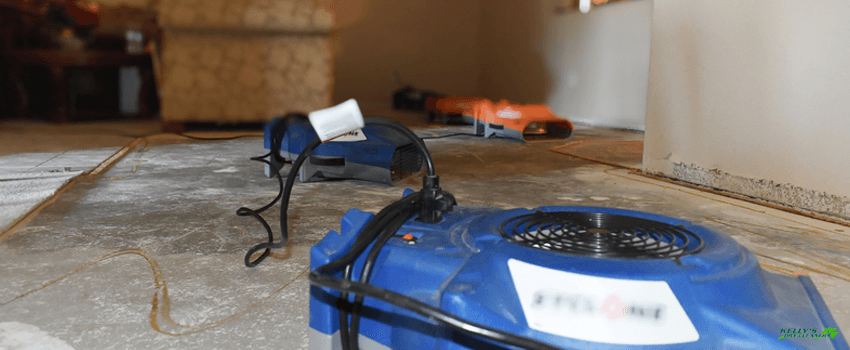Water damage to your home can occur without warning.
There are numerous scenarios in which water damage mitigation and restoration services may be necessary. While on vacation, a pipe may rupture and overflow your basement caused by a leak. Due to poor maintenance, your dishwasher may suddenly malfunction and flood your wooden kitchen floor. A thunderstorm may trigger a leaking roof to collapse, resulting in water damage to your home’s structural system.
It is crucial to understand the water damage restoration processes to know what to expect when water damage restoration experts arrive at your home or business. However, what is the distinction between water mitigation and water restoration? Discover the differences between water mitigation and water restoration here.
What is Water Mitigation
The water mitigation process minimizes more water damage to your property and possessions. The water mitigation process requires the application of specialized equipment and techniques, such as:
-
The removal of damaged furnishings and materials, such as drywall and flooring.
-
Sanitizing and decontaminating salvageable goods.
-
Guaranteeing the structural integrity of the home.
-
Using industrial-grade equipment to extract water and dehumidify the home.
-
Protecting the home’s integrity by covering up windows, installing tarps, and taking other steps as necessary.
The purpose of water damage mitigation services is not to restore or replace destroyed property but to prevent the disaster from having additional repercussions. While water mitigation may avoid additional damage, the service is frequently only a temporary fix.
What is Water Damage Restoration
The water damage restoration process emphasizes on repairing and restoring water damage to property. The purpose of the water damage restoration process is to assist homeowners in recovering from all harm. After water mitigation, numerous experienced water damage restoration professionals will focus on deconstructing and rebuilding your property using some applications. Typical water damage restoration services often consist of the following:
-
The replacement of damaged walls and floors.
-
Eradicating mold.
-
Fixing roof damage.
-
Performing humidity and moisture tests to check that all problems have been rectified.
The primary objective of water damage restoration is to restore the property to its previous state. Since no repairs can be completed until all water damage issues have been resolved, the water restoration procedure cannot begin until the water mitigation phase has concluded.
Difference Between Water Mitigation and Water Damage Restoration
-
Repairing or restoring damaged property and possessions is not included in water mitigation.
-
When it comes to water damage, mitigation services help ensure that the damage is minimized. Do note that only short-term relief is provided by water mitigation.
-
In contrast, water restoration is the total package. It includes everything, from evaluating the water damage to cleaning and rebuilding your entire house.
-
Water restoration focuses on cleaning everything that may have been damaged by water damage, including ducts and vents.
-
Water restoration is essential because water damage extends far beyond property destruction, and drying and cleaning alone are insufficient.
Common Water Mitigation and Restoration Myths
If you have to deal with water damage in your home or business, you may consider handling it yourself. Consider these misconceptions and consequences before undertaking the task.
Myth 1: Replacements are less expensive.
Do not expect that repairing broken items and furniture will save money. A restoration firm that offers comprehensive services can detect and clean salvageable furniture and things, such as appliances, electronics, and personal possessions. Frequently, the price of restoration is significantly less than that of brand-new things.
Myth 2: Air drying is economical.
Without mitigation, your property will eventually dry out. However, air drying is not economical. Moisture that lingers on floors and behind walls damages and worsens the condition of materials. It fosters mold growth that spreads over a moist environment. The delayed expense of fixing these issues escalates significantly.
Myth 3: DIY water mitigation is straightforward.
You can rent small water extraction systems from home improvement stores if you are familiar with using such equipment. Drying structures is essential to the process and necessitates additional equipment. Overall, entrusting water mitigation to professional expert contractors is safer and more convenient.
Ultimate Benefits of Water Damage Restoration
First Benefit
Understandably, having water issues on your household or commercial property might be burdensome. However, there is no reason to delay it. If you ignore water damage for a short time, it will progressively spread to other areas of your home.
In addition to affecting your walls, floors, and ceiling, mold also causes harm to your furniture, electronics, and appliances. Slow progress can exacerbate the situation. To prevent more water damage to your house or business, water damage restoration professionals will clean up the damage quickly and effectively.
Second Benefit
Molds result from water damage, as has been stated numerous times. However, mold and mildew are also addressed by a water restoration service besides water damage.
Here is where a professional water restoration service comes in handy. The specialists’ primary objective is to extract as much and quickly as possible. Using the most effective disinfectants will swiftly eradicate mold and mildew growth and prevent it from returning. When molds are eradicated, chronic respiratory disorders and mold allergies will disappear.
Third Benefit
When vents and pipes are not properly treated, mold will grow and spread throughout your home, releasing spores and producing a musty odor.
If you engage a water restoration company, you can resolve this issue. The mechanisms reverse more than just the consequences of water damage. However, they would also evaluate the most minor elements to eliminate the damage.
Conclusion
Whether the water damage has occurred in your home or your place of business, the situation may appear overwhelming. Now, you have a better idea of what to anticipate from the recovery process because you have a firm grasp on the distinction between water mitigation and water damage restoration. Keep all the above information handy in unexpected water damage emergencies.
In Times of Water Damage, Let Kelly’s Dry Cleaners Assist you the Best Way they Can.
If you ever experience a water damage accident, such as basement flooding, sewage backup, or commercial water damage, contact a reputable water damage restoration in Durango, CO, immediately. Our skilled specialists have the necessary equipment and expertise to efficiently implement water damage mitigation and water restoration. They can get your home or business back to normal quickly in no time.



